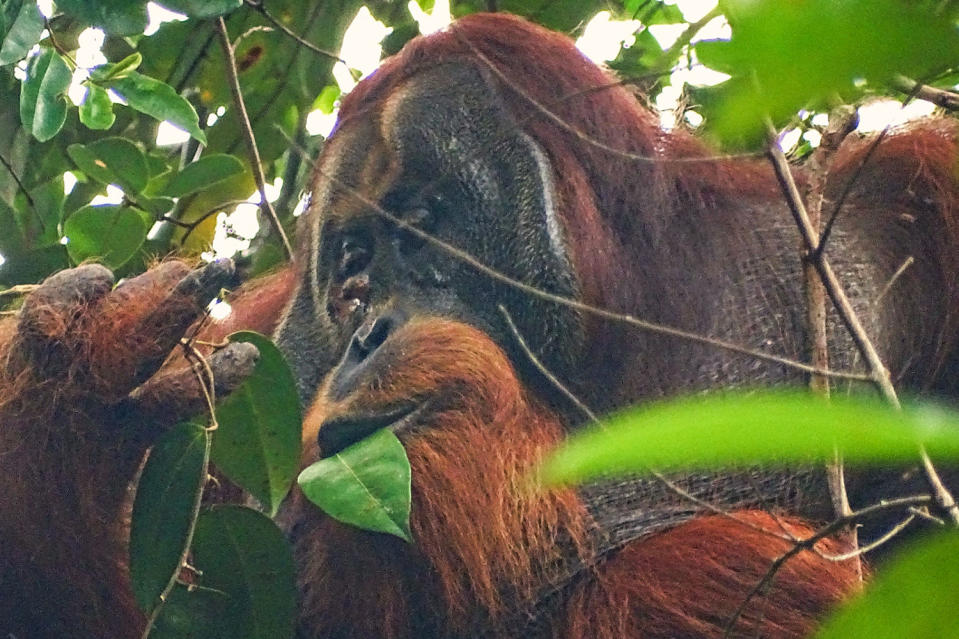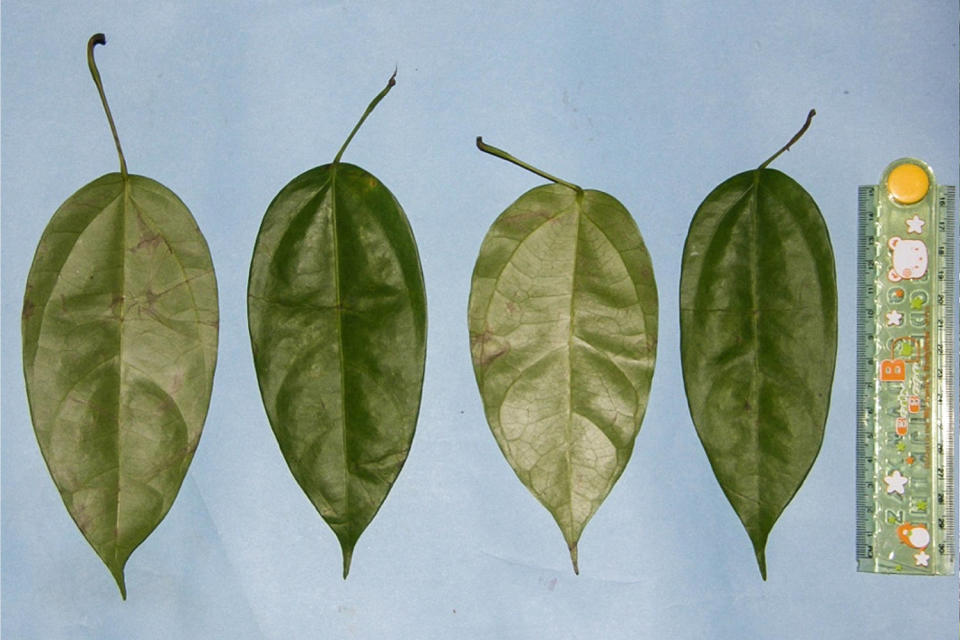An orangutan named Rakus went through a rough patch in the summer of 2022.
Researchers heard a fight between male orangutans in the treetops of a rainforest in Sumatra, Indonesia; a day later they saw Rakus with a pink wound under his right eyelid.
A piece of meat the size and shape of a puzzle piece was missing. When Rakus, who is most likely in his 30s, had a long conversation, researchers noticed a new wound in his mouth.
Over the next few days, researchers monitored Rakus from a distance – and saw something so surprising that they eventually reported on it in detail in the journal Scientific Reports.
According to their research, published Thursday, Rakus was observed repeatedly chewing the leaves of a particular vine plant over several days. The creeper is not a typical food for orangutans, but is known to humans as a painkiller.
On at least one occasion, Rakus made a paste from the chewed leaves and applied it to his face. It is the first time that an animal has applied medicine to a skin wound.

“It’s the first documentation of external self-medication – applying leaves, I would say, as a poultice, the way people do to treat wounds and pain,” said Michael Huffman, associate professor at the University’s Wildlife Research Center Kyoto. Japan, which was not involved in the new study.
Rakus’ wound never showed signs of infection and closed within a week.
The discovery is new evidence that orangutans can identify and use pain-relieving plants. A growing body of research suggests that other species also self-medicate, with varying levels of sophistication.
The researchers behind the study believe that great apes’ ability to identify drugs and treat wounds can be traced back to a shared ancestor with humans.
New evidence that orangutans self-medicate
The discovery was only possible because Rakus spends his days in a protected rainforest area, the Suaq Balimbing research area, in Indonesia’s Gunung Leuser National Park.
Researchers have been observing orangutans there since 1994. Today, about 150 people call the area home. Rakus, first sighted there in 2009, is a resident or frequent visitor.
Scientists often monitor an individual orangutan in the area from early morning – when it leaves its night nest – until it builds a new night nest about twelve hours later.
“We are not disturbing the orangutan,” says Isabelle Laumer, author of the new study, primatologist and cognitive biologist at the Max Planck Institute for Animal Behavior in Germany. “They completely tolerate us following them.”
Laumer said researchers had never before seen orangutans in the area self-medicating the way Rakus did, and it was not clear how he developed this behavior.


It’s possible that Rakus learned to treat his wound through “individual innovation,” Laumer said, after accidentally touching a finger with a pain-relieving leaf juice. Or perhaps he learned the behavior culturally from other orangutans early in life.
Orangutans are social learners and have been shown to be proficient with tools. They develop advanced knowledge of food from their mothers.
“For example, they learn a lot about which fruits to eat, where to find them, when to find them, when they are ripe and how to process them,” says Laumer. “Some orangutans feed on up to 400 different plants. … This is quite a bit of intensive knowledge that they actually have to acquire.”
Have humans learned about healing plans from animals?
Evidence of self-medication in animals has increased in recent decades.
In the 1960s, famed primatologist Jane Goodall noted that chimpanzees in Tanzania ate whole leaves of a plant later identified as a species of Aspilia shrub. Decades later, Huffman wrote an article describing how another population of chimpanzees ate the bitter pith of a certain daisy, but only rarely and when other behavior suggested they were ill.
Researchers think chimpanzees evolved such behavior to treat or prevent parasites.
In the 1990s and 2000s, a flurry of research revealed additional examples of self-medication.
A notable 2008 study of Bornean orangutans documented three females rubbing their bodies with a paste of chewed Dracaena cantleyi plant, which local indigenous people use to address joint and bone pain.
Huffman said he thinks all species self-medicate to some extent. Researchers have even documented the practice in insects.
“It shows us that animals have control over their lives,” he says. “That they can behave in ways that are flexible, that can adapt to certain circumstances that amount to their survival.”
He theorized that ancient humans derived the ability to identify medicinal plants and substances from close observations of animals.
“Many of the medications that humans have used throughout our history as a species have come from our close connection with nature and looking to other animals for advice and extrapolating what we learned,” Huffman said. “I don’t know of any plant that has been documented as being used as a medicine by an animal that isn’t also used by humans. And I think it’s the people who have learned from the animals.”
Laumer said her team’s findings – in a species that is genetically 97% similar to humans – could provide insight into how ancient primates developed their propensity to use drugs.
“It’s possible that our last common ancestor already exhibited similar forms of ointment behavior,” she said.
Laumer added that the new findings also show how much we can learn from orangutans, which are considered critically endangered. The rainforests where Sumatran orangutans live are disappearing as land is converted to agriculture and climate change intensifies wildfires.
According to the latest estimates, from 2016, there are fewer than 14,000 left.
This article was originally published on NBCNews.com